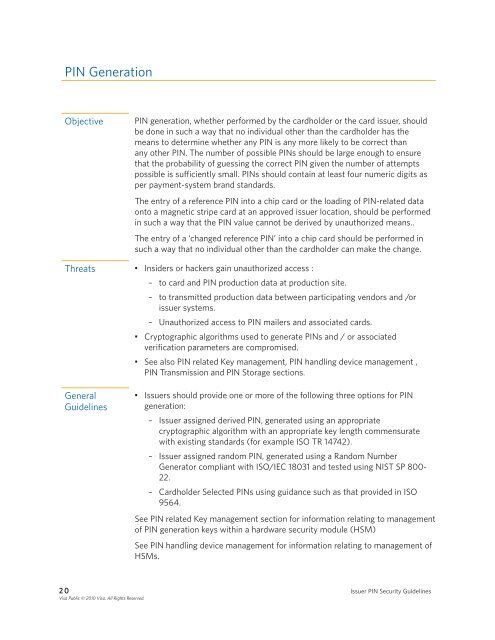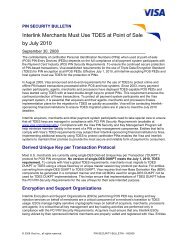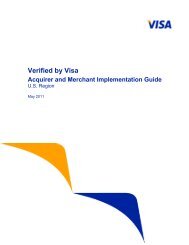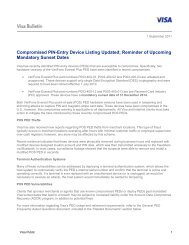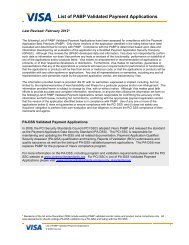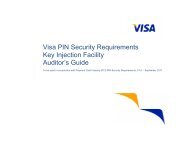Issuer PIN Security Guidelines - Visa
Issuer PIN Security Guidelines - Visa
Issuer PIN Security Guidelines - Visa
Create successful ePaper yourself
Turn your PDF publications into a flip-book with our unique Google optimized e-Paper software.
<strong>PIN</strong> Generation<br />
Objective <strong>PIN</strong> generation, whether performed by the cardholder or the card issuer, should<br />
be done in such a way that no individual other than the cardholder has the<br />
means to determine whether any <strong>PIN</strong> is any more likely to be correct than<br />
any other <strong>PIN</strong> . The number of possible <strong>PIN</strong>s should be large enough to ensure<br />
that the probability of guessing the correct <strong>PIN</strong> given the number of attempts<br />
possible is sufficiently small . <strong>PIN</strong>s should contain at least four numeric digits as<br />
per payment-system brand standards .<br />
The entry of a reference <strong>PIN</strong> into a chip card or the loading of <strong>PIN</strong>-related data<br />
onto a magnetic stripe card at an approved issuer location, should be performed<br />
in such a way that the <strong>PIN</strong> value cannot be derived by unauthorized means . .<br />
The entry of a ‘changed reference <strong>PIN</strong>’ into a chip card should be performed in<br />
such a way that no individual other than the cardholder can make the change .<br />
Threats • Insiders or hackers gain unauthorized access :<br />
– to card and <strong>PIN</strong> production data at production site .<br />
– to transmitted production data between participating vendors and /or<br />
issuer systems .<br />
– Unauthorized access to <strong>PIN</strong> mailers and associated cards .<br />
• Cryptographic algorithms used to generate <strong>PIN</strong>s and / or associated<br />
verification parameters are compromised .<br />
• See also <strong>PIN</strong> related Key management, <strong>PIN</strong> handling device management ,<br />
<strong>PIN</strong> Transmission and <strong>PIN</strong> Storage sections .<br />
General<br />
<strong>Guidelines</strong><br />
• <strong>Issuer</strong>s should provide one or more of the following three options for <strong>PIN</strong><br />
generation:<br />
– <strong>Issuer</strong> assigned derived <strong>PIN</strong>, generated using an appropriate<br />
cryptographic algorithm with an appropriate key length commensurate<br />
with existing standards (for example ISO TR 14742) .<br />
– <strong>Issuer</strong> assigned random <strong>PIN</strong>, generated using a Random Number<br />
Generator compliant with ISO/IEC 18031 and tested using NIST SP 800-<br />
22 .<br />
– Cardholder Selected <strong>PIN</strong>s using guidance such as that provided in ISO<br />
9564 .<br />
See <strong>PIN</strong> related Key management section for information relating to management<br />
of <strong>PIN</strong> generation keys within a hardware security module (HSM)<br />
See <strong>PIN</strong> handling device management for information relating to management of<br />
HSMs .<br />
2 0 <strong>Issuer</strong> <strong>PIN</strong> <strong>Security</strong> <strong>Guidelines</strong><br />
<strong>Visa</strong> Public © 2010 <strong>Visa</strong>. All Rights Reserved.


